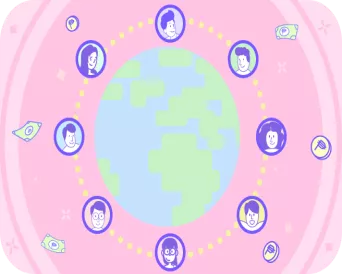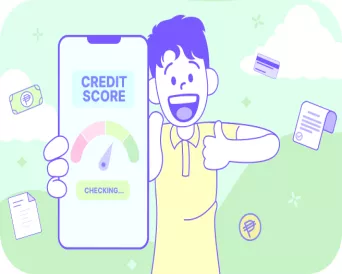Loans play a crucial role in our lives, helping us achieve our goals, whether it's starting a business, buying a dream home, or managing unexpected expenses. That’s why it’s important for every Filipino to take a closer look at the ins and outs of the lending market. We need to keep ourselves updated about the latest loan statistics in the Philippines to guide our financial decisions.
But researching about these important figures can become pretty overwhelming and time-consuming for the average Filipino. We know you’ve got a lot on your plate, luv! So we have a special treat for you.
In this article, we’re giving you a rundown of the most interesting loan statistics in the Philippines you need to know today. Plus, we’re exploring the influence of several factors that shape and continue to reshape the local lending market.
Ready your thinking hats, luv and let’s dive in!
Table of Contents
- Overview of the Lending Market in the Philippines
- Types of Loans in the Philippines
- Interesting Loan Statistics in the Philippines
- Demographic Factors in Loan Statistics
- Impact of Economic and Political Factors on Loan Statistics
- The Effect of COVID-19 on Loan Statistics
- Future Trends in the Lending Market
- Conclusion

Overview of the Lending Market in the Philippines
The lending market in the Philippines is dynamic and diverse, catering to the varying financial needs of individuals and businesses. Here are some key players in the market:
1. Banks
When it comes to borrowing money, banks are the go-to option for many Filipinos. They provide a wide range of lending services to individuals, businesses, and organizations across the country.
With their extensive networks and established reputation, banks offer a sense of reliability and stability. Banks in the Philippines offer various loan products tailored to different needs. Whether you're looking for a personal loan to fund your dreams, a housing loan to purchase your dream home, or a business loan to expand your enterprise, banks have got you covered. They provide flexible terms and competitive interest rates, giving borrowers options that suit their financial capabilities.
Additionally, some banks offer incredible convenience through their digital platforms. You can apply for loans online, making the process faster and more accessible.
2. Non-Banking Financial Institutions
While banks dominate the lending market, non-banking financial institutions (NBFIs) have emerged as key players, especially in promoting financial inclusion and catering to underserved communities. These include microfinance institutions, credit cooperatives, and other finance companies like online lenders.
Microfinance institutions, like peer-to-peer lending platforms, specialize in providing small loans to entrepreneurs, small businesses, and low-income individuals. They prioritize accessibility and focus on empowering borrowers to improve their livelihoods. These institutions often have lower loan requirements and offer financial literacy programs to support borrowers in managing their funds effectively.
Credit cooperatives are another significant player in the lending landscape. By pooling members' savings and resources, cooperatives provide affordable loans to their members. These loans can be used for various purposes, including education, housing, and livelihood projects. Although, their loan amounts can be restrictive for some borrowers.
Lastly, finance companies offer loans and credit facilities to individuals and businesses, often specializing in specific sectors or industries. They provide an alternative source of financing for borrowers who may not meet the stringent requirements of banks. They often have streamlined processes and more lenient criteria, making borrowing more accessible to a broader range of borrowers.
But beware, luv. Not all online lenders are legit. Make sure to do your research before engaging with any of them!
3. Government Financial Institutions
Government financial institutions (GFIs) play a crucial role in supporting key sectors of the economy and driving development in the Philippines. Land Bank of the Philippines, the Pag-IBIG Fund, and Development Bank of the Philippines are notable examples of these.
GFIs often have a broader mandate beyond profit-making, as their primary goal is to support government initiatives and national development priorities. They leverage their resources and expertise to provide loans and financial assistance to sectors that may face challenges accessing funding from other sources.
TOCTypes of Loans in the Philippines
Let's take a look at the different types of loans available in the Philippines and their characteristics:
-
Personal Loans: Personal loans are versatile and can be used for various purposes, such as debt consolidation, home renovations, medical expenses, or travel. They typically offer flexible repayment terms and may or may not require collateral, depending on the lender.
-
Home Loans: Home loans, also known as housing loans, help borrowers purchase or construct their dream homes. These loans offer long repayment tenures and competitive interest rates. Usually, you need to present collateral to get approved for this loan.
-
Car Loans: Car loans enable individuals to purchase a vehicle of their choice. Loan terms for car loans depend on the vehicle's value and loan tenure.
-
Business Loans: Business loans provide capital to entrepreneurs and business owners for various purposes, such as expansion, equipment purchase, or working capital. They often require a detailed business plan, collateral, and proof of revenue generation.
-
Online Loans: Online lenders offer convenient and fast loan processing through digital platforms. These loans are typically short-term and cater to immediate financial needs. But some online loans have higher interest rates due to their quick approval process.
-
Payday Loans: Payday loans are short-term loans designed to cover urgent expenses until the borrower's next payday. They offer quick access to cash but usually come with higher interest rates and fees, so choose wisely, luv.
Interesting Loan Statistics in the Philippines

Q: How much is the total loan portfolio in the Philippines?
A: The lending industry grew by a whopping P1 trillion in April 2023 compared to the same period last year! That means the total loans in the Philippines is at P11.67 trillion. That’s composed of loans from commercial banks, government banks, rural banks—and yes even digital banks like us, luv!
Here’s a breakdown of loan amounts per loan type as of April 2023:
| Loan Type | Amount |
| Consumer Loans | P1.4 trillion |
| Motor Vehicle Loans | P460 billion |
| Credit Card Receivables | P589 billion |
| Salary Loans | P394 billion |
Q: What is the current average interest rate for loans in the Philippines? How does it compare to previous years?
A: Based on preliminary data from the BSP, the average interest rate for loans from banks, also known as bank lending rate, dropped to 7.29% in April 2023. It is still greatly higher than the average interest rate recorded in 2022 at 5.57%. But it is still higher than the interest rate recorded in 2022. However, it is slightly lower than the average interest rate in March, which hit 7.35%.
Q: How many credit card users are there in the Philippines?
A: According to the Credit Card Association of the Philippines, there are 7.5 million Filipino credit card users as of March 2023. They also said that in the first 3 months of the year, they were able to issue nearly 12 million cards nationwide. Credit card users are also practicing revenge spending, with gross billing surging to P410 billion from January to March 2023.
Q: How much bad loans are there in the Philippines?
A: Bad loans, or more technically known as non-performing loans (NPLs), are loans that have been in default or loans that have been late for the past 90 days. Bad loans in the Philippines hit P427 billion in April 2023. This is a 3.05% jump from the previous month, but it’s lower by 4.5% from April 2023. Here’s a breakdown of bad loans per bank type:
| Loan Type | Amount | NPL Ratio |
| Universal & Commercial Banks | P363 billion | 3.11% |
| Thrift Banks | P45 billion | 6.95% |
| Rural & Cooperative Banks | P18 billion | 8.36% |
| Digital Banks | P1.4 billion | 7.43% |
Here’s a breakdown of bad loans per loan type as of March 2023:
| Loan Type | Amount | NPL Ratio |
| Consumer Loans | P146.46 billion | 6.39% |
| Motor Vehicle Loans | P35 billion | 7.89% |
| Credit Card Receivables | P22.04 billion | 3.85% |
| Salary Loans | P70 billion | 75.12% | Residential Real Estate Loans | P70.4 billion | 77.46% |
Q: How many Filipinos are taking out loans?
A: The BSP says that most Filipinos have or had debts. Their Financial Inclusion Report revealed that as much as 47.1% of Filipino adults borrow money. Only 19% of the Filipino adult population do not borrow at all.
TOCDemographic Factors in Loan Statistics
When it comes to understanding loan statistics, there are a multitude of factors at play that contribute to lending patterns and trends. Here are some of the most common demographic factors that affect the lending market of the Philippines:
- Age: Younger borrowers who are just starting their careers or pursuing higher education may have limited credit histories and lower incomes. As a result, they may qualify for smaller loan amounts and potentially higher interest rates. That’s the reason why those aged 40-49 can take out more loans. Conversely, loan approvals remain lowest among young adults aged 15-19.
- Income Level: Income level is a crucial determinant of loan amounts and interest rates. Higher-income individuals often qualify for larger loan amounts due to their ability to demonstrate repayment capacity. They are also seen as lower risk. But did you know? According to the BSP, there are more borrowers from the lower income bracket than those with higher economic standing.
- Employment Status: Employment stability and a regular income are critical factors considered by lenders. Those with stable employment are eligible for larger loan amounts and lower interest rates. Self-employed (and yes, even unemployed individuals) are often asked to provide additional documentation to their lenders.
- Marital Status: It’s true, luv. If you’re single, you may find it harder to get approved for a loan in the Philippines. The BSP notes that only 9% of singles who apply for a loan get approved. Meanwhile, married, separated, widowed, and divorced individuals have a higher chance of getting a loan.
- Location: Geographic location can influence loan amounts and interest rates due to variations in economic conditions and living costs. Borrowers in urban areas may have higher borrowing needs and may qualify for larger loan amounts. Interest rates may also reflect the economic activity and competition among lenders in a specific region. In rural areas, loan products may be tailored to support agricultural activities or microfinance for small-scale businesses.
Suggested Read: How to Choose the Best Personal Loan for You
TOCImpact of Economic and Political Factors on Loan Statistics
Aside from demographic factors, some economic and political factors also impact the lending market in the Philippines. These include:
- GDP Growth: In recent years, the Philippines has been experiencing steady economic growth, with an average GDP growth rate of around 6% before the COVID-19 pandemic. This growth has led to increased business activities and investment, resulting in higher demand for loans from businesses looking to expand their operations and finance their projects.
- Inflation Rate: As of the most recent data, the Philippines has been grappling with moderate inflation. Inflation affects the purchasing power of Philippine Peso, which in turn dictates prices of goods and services. In response to the inflationary pressures, the BSP has implemented monetary measures, including adjustments to policy rates. These measures impact lending by influencing the interest rates offered by banks, thereby affecting borrowing costs for individuals and businesses.
- Unemployment Rate: Financial constraints due to unemployment forces many Filipinos to take out more loans. However, sudden unemployment also affects bad loans because individuals facing job losses or income reductions may struggle to meet loan repayments. But thankfully, the unemployment rate in the Philippines has been on a decline since 2021.
- Government Policies and Regulations: Government policies play a significant role in shaping the loan market by influencing lending practices, borrower behavior, and overall market dynamics. They have a say in setting benchmark interest rates and passing laws that could either make or break the lending market. Some policies that have reshaped the loan market in the Philippines include the Bayanihan to Recover as One Act and the Truth in Lending Act.
- Financial Stability and Market Conditions: The stability of financial markets and the overall economic environment play a crucial role in lending. Recent market conditions influenced by the COVID-19 pandemic and global economic uncertainties have led to cautious lending practices by financial institutions. Banks may tighten their lending criteria and exercise prudence in loan disbursements to mitigate risks.
- Exchange Rates: Fluctuations in exchange rates can impact borrowing costs for individuals and businesses with foreign currency-denominated loans. Recent exchange rate movements, such as the weakening of the Philippine peso against major currencies, can result in higher loan repayment obligations for borrowers with foreign currency loans, potentially affecting their loan affordability.
- Political Stability: Political stability is also an important factor for investor confidence and economic growth, luv. If people (residents and foreign investors alike) don’t have confidence in the Philippine economy, it negatively impacts the lending market. A stable political environment fosters economic activities and encourages lenders to provide loans with confidence.
The Effect of COVID-19 on Loan Statistics
Remember having to go on lockdowns due to COVID-19? Not trying to trigger you, luv! But we know for a fact that the recent pandemic has totally shaken things up… and you bet the lending market felt the impact too!
The pandemic had unleashed a wave of uncertainty, leading to shifts in borrower behavior and altering the lending landscape. So, with everything going topsy-turvy, people and businesses were hit hard financially. Lots of folks needed emergency loans and a little extra help to stay afloat. That's why loan volumes in certain sectors shot up like crazy!
Thankfully, the government swiftly implemented relief measures to help not just ordinary citizens, but businesses and financial institutions, too. First, they introduced loan moratoriums, which let borrowers hit pause on repayments for a bit. It was like a breather for those struggling to make ends meet. Plus, they pumped in stimulus packages to get the economy back on track. These measures were a lifeline for borrowers, many of which were Micro, Small and Medium Enterprises that kept the economy going, and gave them some much-needed relief.
In fact, in the National Economic and Development Authority’s (NEDA) recent report, they highlighted that the International Monetary Fund cited the BSP’s policy borne out of the pandemic as one of the Philippine’s strengths during this global standstill. Based on this report, our loan statistics in the Philippines still came out pretty outstanding:

-
The financial industry recovered and posted a 7 percent asset growth in 2021.
-
Total loan portfolio 4.8 percent in 2021 from a 0.9 percent contraction in 2020, while the non-performing loan (NPL) ratio remained manageable at 4 percent.
-
Other key financial indicators that look positive for the sector:
- universal and commercial banks’ solo capital adequacy ratio and common equity tier 1 ratio stood at 16.5 percent and 15.3 percent, (above the BSP’s threshold of 10 and 6 percent, respectively)
- liquidity coverage ratio registered at 200.9 percent (above the BSP threshold of 100 percent, on a solo basis)
Future Trends in the Lending Market

Looking ahead, it’s undeniable that the future of lending is digital.
The pandemic pushed us into a world where everything is online, and lending is no different. Fintech companies are going to take center stage with their innovative, tech-driven solutions. Think online loan applications, speedy approvals, and all that! It's going to make getting a loan a breeze!
The best part is that newbies in digital banking, armed with digital banking licenses certified by the BSP, are helping drive financial inclusion in a legitimate way. There’s no need to panic over their credibility and operational stability since they have been vetted and continue to be regulated by the BSP.
Looking at the financial sector’s road map ahead, there’s still plenty of innovations and improvement for digital lending but we can sleep soundly with fiscal policies that are set in place.
Oh, and let's not forget about blockchain! This fancy technology has the potential to overhaul the lending game. It can make financial transactions super secure, efficient, and cheap. We're talking about streamlining the whole lending process and making sure everything is transparent. It's still early days for blockchain lending platforms, but they're showing serious promise.
TOC
But let’s be real, luv. It isn’t all sunshine and rainbows. We need to find that sweet spot between innovation and keeping things in check. We need rules and regulations to protect folks and keep the lending market stable.
So, as we move forward into this post-pandemic world, it's important to keep tabs on the ever-changing loan statistics and market trends in the Philippines. We need to adapt to what borrowers need, embrace tech, and build a lending system that can weather any storm. Together, we'll shape the future of lending!
![man thinking while looking up at charts representing loan statistics in the Philippines]](/sites/default/files/styles/blog_main_landing_page/public/2023-07/070623-Blog-Loan-Statistics-in-PH1248x589---SEO-Main.png.webp?itok=1OJ4K9OL)





